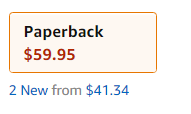My Bullseye Marketing book is now available on Amazon. Setting up the Kindle and paperback versions was a fascinating look into Amazon’s pricing algorithms.
When I setup the ebook version they gave me two pricing options:
- I would get 70% of the sale price but could only charge between $2.99 to $9.99, and they’d charge an additional fee per GB for the download (because their bandwidth is so expensive?), or
- I would get 35% of the sale price and could charge whatever I wanted up to $200.
They also had a chart showing what their data showed them was the best price for my book based on “similar” books: $5.99.
Frankly, I didn’t think that their algorithm could take into account quality or branding. Just as a matter of quantity, how many 350+ page marketing books with over 100 full-color images did they have? Not many. And even fewer with some of the features of Bullseye Marketing, such as the interviews with eight industry experts and the long piece by MailChimp’s CEO Ben Chestnut on how to write a great email. And in terms of branding, IMHO a price of $5.99 (of which I’d get $2.09) just smacked of a low quality title. So I chose Door #2 and priced the ebook at $16.95.
Then when I setup the paperback version the fun really started. For bookstores I’ve set a suggested retail price of $39.95 per copy, of which I get less than $6. But when I got to Amazon’s paperback pricing page they said that their printing cost is $27.45 per copy – roughly double what I pay my other very high quality print on demand vendor servicing bookstores – and so the minimum I could charge on their site is $45, of which I would get $.01!
I think that the printing fee, minimum price and the split are ridiculous, but Amazon owns 85% of the ebook market and over 50% of the physical book market. For me to get anything I had to set the price higher than $45 (and they would get half of the addition amount). I very reluctantly set it at $59.95 (“You think your book is plated with gold?”) and Amazon will get more than five out of every six dollars.
When I thought about it, I figured that within a few days they would probably set a special “discounted” price for Prime members. As my father used to say about items on sale, “Mark it up to mark it down.”
What surprised me was when I noticed a couple days later that Amazon listed “2 new from $41.34”. Who else was selling it so fast?

It turns out that a company called PBShop US is – at much closer to the proper price (with free but slow shipping). My assumption is that they’re a kind of book arbitrageur: their computers see when Amazon lists a new book, checks for other printers where they can order it and the price, sees what Amazon’s markup is, and if they can get it cheap enough elsewhere they offer it for sale. They have apparently automated this since they have a 97% satisfaction rating from close to 500,000 reviews.

Jeff Bezos may say things like, “We see our customers as invited guests to a party, and we are the hosts. It’s our job every day to make every important aspect of the customer experience a little bit better”, but you can usually get a better price on Amazon for the identical item if you’re willing to move your eyes a few inches, or make one more click.
I’m still investigating alternatives to get the online price down to the bookstore $39.95. Most people who come to Amazon will see that big $59.95 price that I hate. Maybe Amazon will knock it down in a few days as I speculated/hoped.
But if you want to get the paperback for $39.95, you can go into your local bookstore and order it. They may even discount it a bit from the MSRP.
If you want to get 25% off of the paperback price, host me to speak to your conference or group. I’ll bring copies to sell for only $29.95.
And that $16.95 ebook looks better and better.
